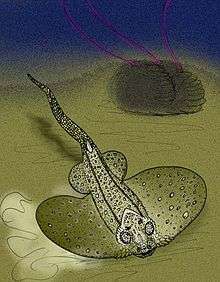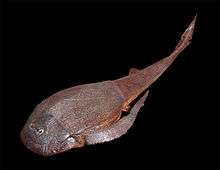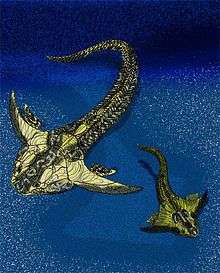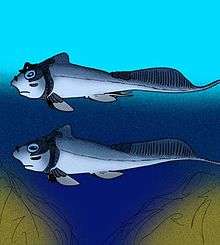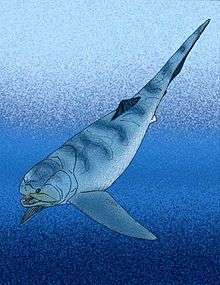Rhamphodopsis
Rhamphodopsis is a genus of extinct ptyctodont placoderm from the Middle Devonian Old Red Sandstone of Scotland.[1]
| Rhamphodopsis Temporal range: Middle Devonian | |
|---|---|
 | |
| Scientific classification | |
| Kingdom: | Animalia |
| Phylum: | Chordata |
| Class: | †Placodermi |
| Order: | †Ptyctodontida |
| Family: | †Ptyctodontidae |
| Genus: | †Rhamphodopsis Watson, 1934 |
| Type species | |
| †Rhamphodopsis thrieplandi Watson, 1934 | |
| Other species | |
| |
Species
There are two species of Rhamphodopsis recognized.
R. thrieplandi
This is the type species, and the smaller of the two described species, the adult total length being up to 7 centimeters. The median dorsal spine is shorter than the anterior lateral spines.
R. trispinatus
This is a much larger, more robust species, the adult total length being up to 12 centimeters. The main way to distinguish small individuals of R. trispinatus from individuals of R. thrieplandi is that the median dorsal and anterior lateral spines of R. trispinatus are both proportionally equal lengths and are proportionally longer than those of R. thrieplandi.
gollark: Well, it's not very scaleable, but it looks like it... works.
gollark: π/[DATA EXPUNGED]/6
gollark: Replying to https://discord.com/channels/198130613759246337/198142140805677065/746856978365808731I mean, my things just use dynmap for player tracking directly.
gollark: By which I mean "swapped out a tiny bit of the signal processing frontend and display logic", but you know.
gollark: Well, yes, I rewrote my software to track those.
References
- Denison, Robert (1978). Handbook of Paleoichthyology, Volume 2, Placodermi. New York: Gustav Fischer Verlage. p. 32. ISBN 9780895740274.
- Fossils (Smithsonian Handbooks) by David Ward (Page 197)
This article is issued from Wikipedia. The text is licensed under Creative Commons - Attribution - Sharealike. Additional terms may apply for the media files.
